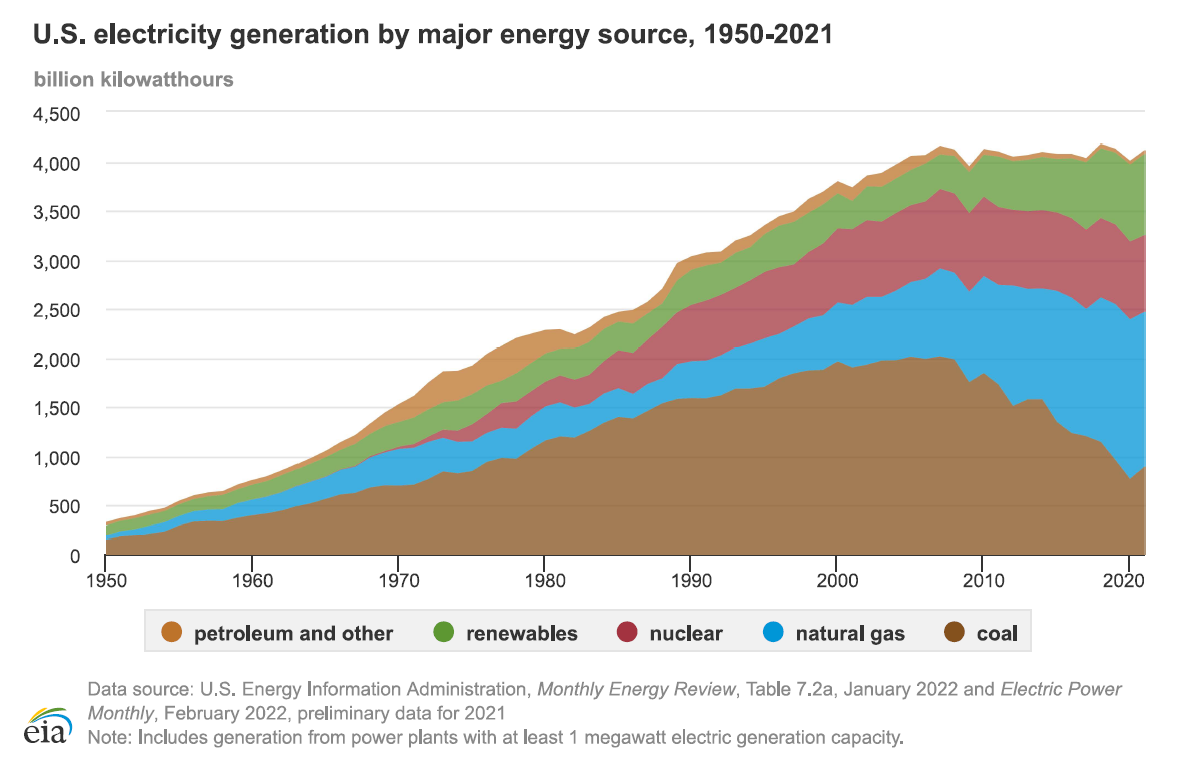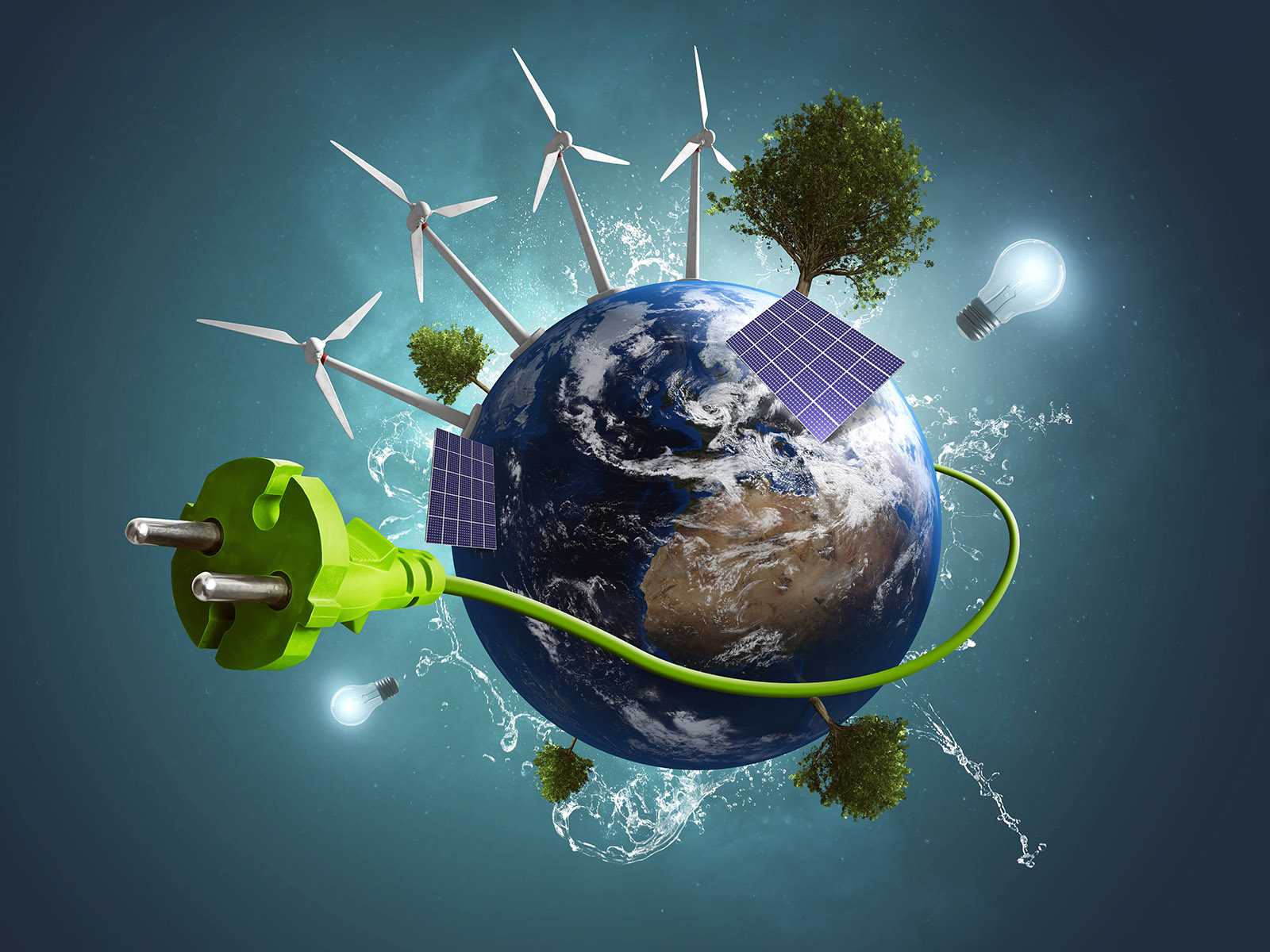Renewable Integration
What is renewable integration?
Renewable integration is the process of plugging renewable sources of energy into the electric grid. Renewable sources generate energy from self-replenishing resources—like wind, sunshine, and water—and could provide enough energy to power a clean future. These sources of energy are very different from fossil-based energy sources, which can create challenges when integrating renewable energy with the grid. Overcoming these challenges is key to increasing renewable integration and achieving a clean energy future.
Sources of renewable energy, such as water and geothermal, can generate steady and consistent energy to meet baseload power needs, which is the minimum amount of power the grid needs at any given time. These renewables function similar to fossil fuel plants which are able to provide reliable power to meet changing customer demands. However, the amount of energy generated from other renewables, like wind and solar sources, can vary significantly throughout the day, the season, and in different locations. That’s because these renewables rely on resources—wind and sunshine—that fluctuate and are not available everywhere at all times. This is an important consideration because the amount of electricity fed into the grid must always be equal to the amount of electricity used or taken out the grid. Imbalances in grid power can lead to power outages. The increasing reliance on renewable sources for energy requires a flexible grid and new approaches to balance power supply and demand.
There are clear benefits of increasing renewable integration with the grid. Renewables can reduce emissions of carbon and other air pollutants and are self-replenishing. They support distributed energy systems that lessen power demand on the grid, lower costs, and enhance the reliability and security of critical infrastructure, such as hospitals. These benefits can only be fully realized if energy from renewables is accessible when and where it’s needed, which is why renewable integration is an important area of research.

Brief history of renewable integration
Humans have leveraged renewable sources of energy throughout history—like using wind to propel ships and water to mill grain. It was not until the Industrial Revolution in the 19th century and the rise of electricity that society began to rely heavily on fossil fuels—and later, nuclear energy—to generate power. Since then, fossil fuels have been the predominant source of energy, but there has always been interest in renewables and development of new technologies to better harness the power of natural resources.
Modern approaches to renewable energy appeared as early as the 1800s, with the invention of the first hydrogen fuel cell in 1839, the first solar—or photovoltaic—cell in 1883, and the development of more efficient steel blades for windmills in the 1890s. The first hydroelectric power plant was built in Wisconsin in 1882 and the first geothermal plant was built in California in 1921. Between the 1930s and 1970s, multiple hydropower dams were built in the United States and hydroelectric power remains the dominant source of renewable energy in the United States today.
The energy shortages and oil crises of the 1970s dramatically increased interest in renewable sources of energy and led to the building of the first large-scale wind farm and solar power plants during the 1980s in California. Growing concerns about carbon emissions and climate change have further accelerated the use of renewables over the last 20 years. In 2020, 12% of the total US energy consumption was met using renewables and the U.S. Energy Information Administration estimates that consumption of renewable energy will increase through 2050, underscoring the need for improved renewable integration with the grid.

Why is renewable integration important?
Carbon emissions drive climate change—predicted to increase global temperatures up to 2 degrees Centigrade by the end of the century and lead to more extreme weather events and changes in regional climate. Reducing carbon emissions by using more renewable sources of energy is critical to a zero carbon future. The International Energy Agency estimates that the majority of global electricity will need to be generated using renewables to reach net-zero emissions by 2050. The U.S. has set a goal of generating 100% clean electricity by 2035 and many states have implemented targets for lower emissions—all of which will require an increased reliance on renewables. In the U.S., the use of renewables has increased significantly since 2010, but even higher levels of renewable integration will be needed to achieve a net-zero economy by 2050.
Benefits of renewable integration
Renewable integration is a critical element of a net-zero future that will reduce reliance on fossil fuels and lower carbon emissions, which has far-reaching benefits for society. Generating just 35 percent of U.S. electricity using wind and solar would reduce carbon emissions by up to 45 percent.
Renewable integration supports job creation in the United States. In 2022, job growth in the energy sector outpaced overall U.S. employment, with more than 3 million new jobs added in renewable and green energy sectors. Transitioning to a net zero economy is predicted to create a net increase of one million new jobs while supporting the country’s economic competitiveness. In fact, for every million dollars the U.S. invests, renewables can generate up to 2 times more jobs than fossil fuels.
Renewable integration can support improved air quality and health outcomes by reducing pollution. Increased reliance on renewable sources of energy will decrease air pollution and could eliminate hundreds of thousands of premature deaths associated with poor air quality.
Renewable integration also supports the development of distributed energy systems, which are small-scale power generation and storage options. This includes things like solar panels that can power individual houses or local microgrids that could operate autonomously from the regional grid, decrease power demand during peak times, and lower costs. Distributed energy systems can also increase overall energy reliability and security by providing energy to remote areas and critical infrastructure, like hospitals or emergency response services.
Finally, renewables are sustainable. Unlike fossil fuels, wind, sunshine, and water, are self-replenishing resources that can provide enough energy to power a cleaner future.
Challenges facing renewable integration
Plugging renewable sources of energy into the existing electric grid isn’t as simple as plugging a cord into an outlet. There are multiple considerations and technical challenges that must be overcome to integrate a high percentage of renewables into the grid. This includes developing infrastructure and technology to connect renewables with the grid, coordinating power generation from multiple sources, managing the effects of regional and market demands on local power, and advancing grid storage options.

One challenge to renewable integration is the current infrastructure and technology available to connect renewables with the grid. Limited high-voltage direct current powerlines and transmission capacity in some areas can prevent renewables from being connected to the grid. This is particularly true for renewable energy sources in remote and offshore locations. There are also technology-related challenges to renewable integration. Converting the direct current power generated by renewables into alternating current power that can be distributed through the grid to customers requires having appropriate control and protection technologies in place. New grid-forming inverters and similar control technologies are needed to ensure reliable connections between renewables and the grid.
High levels of renewable integration with the grid pose a challenge to grid operators, who must balance power supply and demand across the grid. Renewables like water and geothermal provide consistent, baseload power that can quickly be ramped up to meet power demand when needed. Other renewables, like wind and solar, naturally fluctuate. Depending on the time of day, season, location, and weather, the energy produced by variable renewable energy sources can change. Meeting power demand while supporting high levels of renewable integration will require extremely flexible grid operations. For example, in some markets solar power could supply most energy needs during the day. But when the sun sets in the evening and power demand stays high, operators must rapidly switch to other energy sources. Ramping up other sources of energy can take time, which is a challenge for grid operators. Another challenge is having accurate weather forecasts. Because weather directly affects how much energy some renewables generate and how much power is consumed, forecasts are an essential tool for grid operators to maintain stable power. Wind conditions are notably difficult to forecast, which is an important consideration in areas with high reliance on wind energy.
Power transmission between regions is another hurdle to achieving high levels of renewable integration with the grid. Renewable energy is not always generated where power demand is high. Providing stable renewable power across the country requires improved energy transmission and storage options to move the energy generated from renewables in one location to locations with no renewable resources or where power demands outweigh renewable energy generation.
Grid energy storage offers solutions to many of these challenges by storing renewable energy when it is abundant for use during times when some renewables are not readily available. But grid storage options also need modernizing to support higher renewable integration. There are many potential options for grid energy storage—including batteries, hydrogen, pumped storage hydropower, and others—but implementing these storage options at grid scale, for long-duration storage, and at reasonable cost remain major challenges. The Grid Storage Launchpad at PNNL is focused on addressing these challenges and advancing the next generation of grid energy storage technologies, which will support increased renewable integration.
Beyond challenges associated with balancing power supply and demand, there are considerations related to permissions and authorizations, potential impacts to the environment and communities, and workforce development for future renewable integration. Establishing clear pathways to equitable renewable energy developments for communities will be key to a resilient grid that can provide clean, reliable energy to more people.
Developments in renewable integration
Finding solutions to these challenges requires advances on multiple fronts to address location-specific energy needs and different markets. Some key areas of research include energy storage and transmission, agile grid operations, and computational and modeling work to support planning and management that meets future energy needs.
Energy storage and transmission are key to overcoming some of the challenges associated with renewables. Storing extra energy to meet demand allows operators to use that energy later when demand is high but supply is low—providing stable power to customers. Also, identifying where there is flexibility in the system and deferring power demand—like implementing automated building controls that heat water or cool offices during off-peak hours—are key tools to better match renewable power supply with system demand.
Improving energy transmission from areas of high energy generation to high energy demand will help overcome some of the geographic and operational barriers to providing reliable renewable energy to all customers.
Other approaches include more flexible operations and planning for increased renewable integration in the future. For instance, relying on multiple renewables for power can balance out fluctuations in any one renewable energy source. Water and geothermal sources provide consistent energy that can be ramped up quickly if power demand spikes, reducing the challenges associated with relying on renewables. Similarly, finding creative solutions to manage power demand throughout the day and providing flexible ramping capabilities can help operators better match renewable power supply with customer demand—like incentives that reduce demand during peak hours or initiatives that support flexible grid operations.
Renewable integration at PNNL
Pacific Northwest National Laboratory (PNNL) is a leader in the research and development of technologies and approaches that will help the nation reach a clean, resilient, and secure energy future. PNNL’s work in renewable integration includes:
- Modeling and analytics efforts to optimize grid capabilities, assess performance of renewable energy systems, and support networks during extreme events or variable energy supply.
- Assessing locations where renewable integration will be most valuable in supporting a resilient grid.
- Optimizing technologies to improve operations and efficiency while reducing costs and emissions.
- Informing power network planning and optimization.
- Developing new economic frameworks to encompass more renewable energy services and costs.
- Evaluating grid data and utility processes to ensure equitable treatment and cost for interconnection and integration.
- Investigating the environmental impacts of renewables.
- Helping communities assess and plan for renewable integration.

Hydropower has a long history in the U.S. and remains the top source of renewable energy generation and energy storage in the country, but modernizing hydropower is posing new challenges for this age-old form of energy. PNNL scientists are part of the Department of Energy’s Water Power Technologies Office (WPTO) HydroWIRES (Water Innovation for a Resilient Electricity System) initiative, which is working to understand and improve hydropower reliability and grid integration. As part of HydroWIRES, PNNL researchers are investigating hydropower’s role in grid resiliency by simulating how much hydropower supports the grid during natural disasters and other forms of power variability. Scientists at PNNL are also evaluating new turbine designs and fish passage technologies to minimize the environmental impacts associated with hydropower.
PNNL is a leader in wind energy research, with scientists evaluating wind behavior and variability to inform the forecasts needed for grid planning and operation. PNNL researchers are building large-scale grid reliability models and engaging industry stakeholders to lay the foundation for deciding where new power lines should be built for integrating up to 80 GW offshore wind generation along the Atlantic coast. PNNL researchers also study the value of wind energy to the grid and to the community being served. A recent study found that offshore wind transmission along the Oregon coast could increase energy reliability to the region and open up energy capacity to other parts of the state. Outcomes of another PNNL study are informing utilities of the economic feasibility for installing wind in isolated microgrid systems in Alaska.
Solar power is among the fastest-growing industries in the U.S. and PNNL is actively improving solar-grid integration with new tools and planning methods to help manage solar variability. This includes tools for testing grid-forming inverters—devices that play a critical role converting direct current electricity produced by renewables into the alternating current electricity that comes from power outlets. A new PNNL-developed simulation allows utility operators to test how to safely add new power sources to the grid in a way that increases power system resiliency and stability.
Interest in marine energy as a renewable power source is growing and PNNL scientists are leading the way in identifying how to best integrate it with the grid. Through the WPTO’s project “Understanding the grid value proposition of marine renewable energy,” PNNL is investigating the unique benefits of marine energy and quantifying its potential value to the grid. As part of that project, the research team found that including marine energy in an energy portfolio can decrease the need for solar and wind up to 50%, all while requiring less battery storage.
PNNL scientists are also supporting the renewable integration of geothermal energy with the grid, which could provide a significant, steady supply of energy to meet baseload power needs. PNNL is part of the large, multi-organization effort Enhanced Geothermal Systems (EGS) Collab which supported the development of the Stimulation and Flow System—designed to improve understanding of underground processes to inform the development of new geothermal energy technologies. PNNL also developed E4D, a system that provides 3-dimensional subsurface images useful in many applications, including monitoring geothermal activity. Other recent developments in this sector from PNNL include new technologies for extracting rare metals from geothermal brine, as well as a techno-economic analysis and report on contracting and financing approaches, all of which could improve the economic viability of this stable renewable energy source to support future geothermal development.